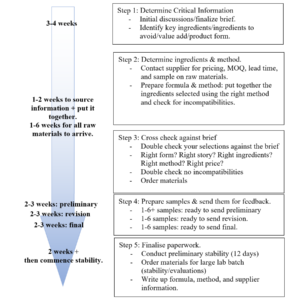Just how do you create that perfect cosmetic formula? This blog will tell you how, in 5 simple steps, to go from concept to approved samples, whilst ensuring the cosmetic formula is exactly what the product development brief has called for.
Cosmetic formulation step 1: Identify the critical elements of the product development brief
The product development brief acts as an informative tool to be used by the concept developer and the Cosmetic Chemist so that it’s clear the type of product that needs to be developed. The brief should describe in words what the concept developer wants the Cosmetic Chemist to create, and ideally be accompanied by comparison samples to demonstrate how the product should feel, smell and/or perform.
The development brief contains the how, what and why of the product to be created; the Cosmetic Chemist’s job is to capture the theory of what the concept developer wants, and put it in a bottle or jar for them.
Critical information needed includes:
- key product details, such as form of the product, required aesthetics, company philosophy, pricing models and ingredients to specifically include or avoid.
- packaging requirements, and ideally samples of the finished product packaging.
Cosmetic formulation step 2: Determine essential ingredients and method required
Once you have identified the form of the product that needs to be created, you can then:
- determine the appropriate ingredients to build the formula, for example:
- o the functional ingredients, to achieve the function of the product;
- o the structural ingredients, to ensure the right form and viscosity;
- o the supportive ingredients, selected specifically to ensure long term stability;
- o active ingredients, to enhance the performance of the product; and
- o added extra ingredients, the ingredients you may need to add to help improve the marketing story of the product.
- determine appropriate inputs (%w/w) of each of the ingredients to meet the functionality, performance and budget needs of the cosmetic formula.
- ‘phase’ materials together.
- prepare a method that suits all materials selected.
It is at this step that you should start contacting cosmetic ingredient suppliers to clarify any compatibilities or processing information, along with pricing, minimum order quantities and lead time on the orders.
Cosmetic formulation step 3: Cross check selected ingredients and amounts against the product development brief.
It is crucial that you cross-check your selections against any limitations of the product development brief, or ingredients the concept developer specifically does not want you to use. This is also a good time to double check all ingredient selections for any specific pH, regulatory or incompatibility requirements.
Use the brief as a checklist to make certain your formulation is addressing all requirements, including budget and time constraints. Make any changes to your formulation selections if required to theoretically fulfill all requirements of the brief. You can now also work on potential pricing of the finished product.
Once this information is confirmed and theoretically suitable, you would order samples of the materials so you can move to the next step: creating product samples.
Cosmetic formulation step 4: Prepare your samples and send out for feedback.
When all of your raw material samples have arrived, you can now head into the lab and prepare your first sample and see how well your theory translates into a finished product.
The first sample is always the worst sample, but gives you a practical sample of the theoretical formula you have prepared. Once you have a tangible product, you can then adjust the theoretical formula and prepare further samples to refine the sample and make it feel, look and otherwise perform as specified by the brief.
It is quite common to need to review your formula and prepare more samples at least 1-6 times to meet the needs of a specific brief when you are experienced at formulating. If you are just new to formulating, do not be surprised if you need to adjust your theoretical formula and prepare revised samples at least 10 or more times.
Once you send your first completed sample to the concept developer (remember, this is likely to be about your fifth revision); they will provide you with feedback from which you can make further adjustments. It is common to need to revise two more times (yes, that means another 3-10 samples each round, depending on your experience), before the final formula is ‘approved,’ or ‘signed off’.
Cosmetic formulation step 5: Finalise paperwork
Once the sample has been confirmed as suitable (signed off) by the concept developer, you are ready to finalise the paperwork. This step involves writing up the final version of the formula with amounts, phase details and method of manufacture. It should also include preparation of a compliant ingredient list and compiling technical data sheets to confirm efficacy of any actives or functional ingredients.
Unless you work for the manufacturing company who will make the final product, you are not able to confirm price, but should be able to estimate what each unit is likely to cost.
The cosmetic formulation process overview:
Here is an overview of the process, steps involved, and likely time taken. Always allow a little extra time in case there are logistical hold-ups or other untimely (and usually uncontrollable) delays.

Enjoyed this article? Get more by subscribing to our newsletter!
Feeling inspired to see ingredients and trends in action?
Then why not visit one of the in-cosmetics events around the world?

